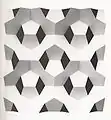Order-6 octagonal tiling
In geometry, the order-6 octagonal tiling is a regular tiling of the hyperbolic plane. It has Schläfli symbol of {8,6}.
| Order-6 octagonal tiling | |
|---|---|
 Poincaré disk model of the hyperbolic plane | |
| Type | Hyperbolic regular tiling |
| Vertex configuration | 86 |
| Schläfli symbol | {8,6} |
| Wythoff symbol | 8 2 |
| Coxeter diagram | |
| Symmetry group | [8,6], (*862) |
| Dual | Order-8 hexagonal tiling |
| Properties | Vertex-transitive, edge-transitive, face-transitive |
Symmetry
This tiling represents a hyperbolic kaleidoscope of 8 mirrors meeting at a point and bounding regular octagon fundamental domains. This symmetry by orbifold notation is called *33333333 with 8 order-3 mirror intersections. In Coxeter notation can be represented as [8*,6], removing two of three mirrors (passing through the octagon center) in the [8,6] symmetry.
Uniform constructions
There are four uniform constructions of this tiling, three of them as constructed by mirror removal from the [8,6] kaleidoscope. Removing the mirror between the order 2 and 6 points, [8,6,1+], gives [(8,8,3)], (*883). Removing two mirrors as [8,6*], leaves remaining mirrors (*444444).
| Uniform Coloring |
 |
 |
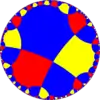 |
|
|---|---|---|---|---|
| Symmetry | [8,6] (*862) |
[8,6,1+] = [(8,8,3)] (*883) |
[8,1+,6] (*4232) |
[8,6*] (*444444) |
| Symbol | {8,6} | {8,6}1⁄2 | r(8,6,8) | |
| Coxeter diagram |
Related polyhedra and tiling
This tiling is topologically related as a part of sequence of regular tilings with octagonal faces, starting with the octagonal tiling, with Schläfli symbol {8,n}, and Coxeter diagram ![]()
![]()
![]()
![]()
![]() , progressing to infinity.
, progressing to infinity.
| Space | Spherical | Compact hyperbolic | Paracompact | |||||
|---|---|---|---|---|---|---|---|---|
| Tiling |  |
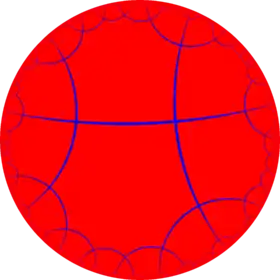 |
 |
 |
 |
 |
 | |
| Config. | 8.8 | 83 | 84 | 85 | 86 | 87 | 88 | ...8∞ |
| Regular tilings {n,6} | ||||||||
|---|---|---|---|---|---|---|---|---|
| Spherical | Euclidean | Hyperbolic tilings | ||||||
 {2,6} |
 {3,6} |
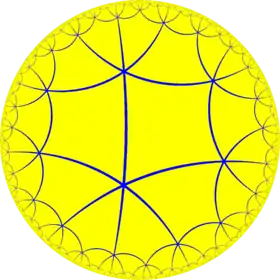 {4,6} |
 {5,6} |
 {6,6} |
 {7,6} |
 {8,6} |
... | 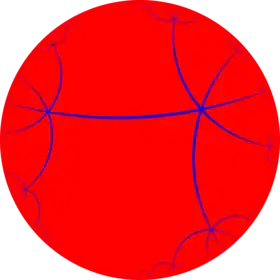 {∞,6} |
| Uniform octagonal/hexagonal tilings | ||||||
|---|---|---|---|---|---|---|
| Symmetry: [8,6], (*862) | ||||||
 |
 |
 |
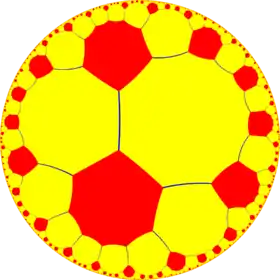 |
 |
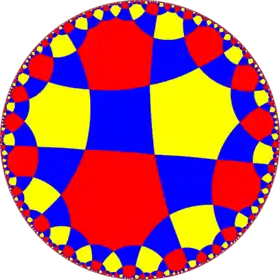 |
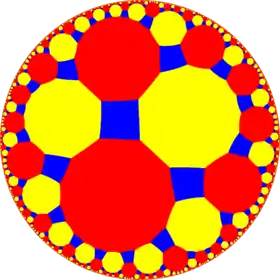 |
| {8,6} | t{8,6} |
r{8,6} | 2t{8,6}=t{6,8} | 2r{8,6}={6,8} | rr{8,6} | tr{8,6} |
| Uniform duals | ||||||
 |
 |
 |
 |
 |
 |
 |
| V86 | V6.16.16 | V(6.8)2 | V8.12.12 | V68 | V4.6.4.8 | V4.12.16 |
| Alternations | ||||||
| [1+,8,6] (*466) |
[8+,6] (8*3) |
[8,1+,6] (*4232) |
[8,6+] (6*4) |
[8,6,1+] (*883) |
[(8,6,2+)] (2*43) |
[8,6]+ (862) |
 |
 |
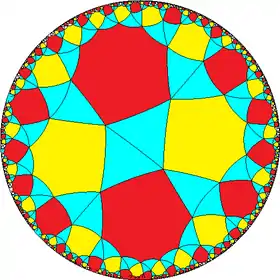 | ||||
| h{8,6} | s{8,6} | hr{8,6} | s{6,8} | h{6,8} | hrr{8,6} | sr{8,6} |
| Alternation duals | ||||||
 |
||||||
| V(4.6)6 | V3.3.8.3.8.3 | V(3.4.4.4)2 | V3.4.3.4.3.6 | V(3.8)8 | V3.45 | V3.3.6.3.8 |
See also
| Wikimedia Commons has media related to Order-6 octagonal tiling. |
- Square tiling
- Tilings of regular polygons
- List of uniform planar tilings
- List of regular polytopes
References
- John H. Conway, Heidi Burgiel, Chaim Goodman-Strass, The Symmetries of Things 2008, ISBN 978-1-56881-220-5 (Chapter 19, The Hyperbolic Archimedean Tessellations)
- "Chapter 10: Regular honeycombs in hyperbolic space". The Beauty of Geometry: Twelve Essays. Dover Publications. 1999. ISBN 0-486-40919-8. LCCN 99035678.

